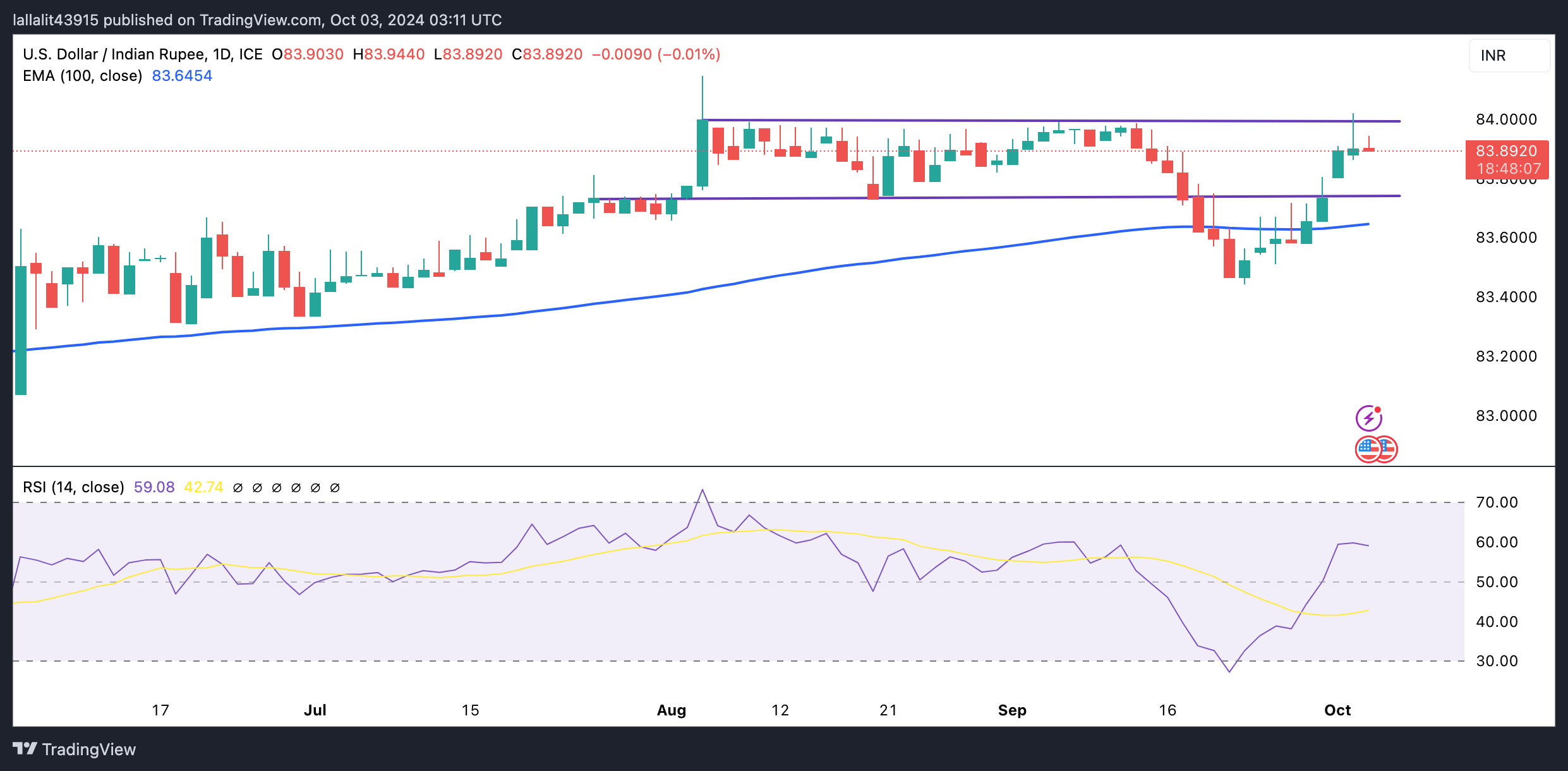USD/INR extends the rally as escalation fears prompt risk-off move

- Indian Rupee edges lower in Thursday’s early European session.
- The risk-off sentiment and higher crude oil prices drag the INR lower.
- Investors await the US September ISM Services PMI on Thursday ahead of employment data.
The Indian Rupee (INR) softens on the day, pressured by the renewed US Dollar (USD) demand. The risk-off mood amid the escalating geopolitical tensions in the Middle East boosts the safe-haven flows, benefiting the Greenback. Additionally, the rise in crude oil prices exerts some selling pressure on the INR as India is the third-largest oil consumer after the United States (US) and China.
Looking ahead, investors will keep an eye on the US September ISM Services Purchasing Managers Index (PMI), the weekly Initial Jobless Claims and the final S&P Global Services PMI, which are due later on Thursday. The attention will shift to the US September employment data on Friday, including Nonfarm Payrolls (NFP), Unemployment Rate and the Average Hourly Earnings. If the jobs report showed a weaker-than-expected outcome, this could prompt the central bank to consider cutting rates deeper, which might exert some selling pressure on the USD.
Daily Digest Market Movers: Indian Rupee remains vulnerable amid multiple headwinds
- The HSBC final India Manufacturing PMI eased to an eight-month low of 56.5 in September. This figure was below the market consensus of 56.7 and the previous reading of 57.5.
- “Momentum in India’s manufacturing sector softened in September from the very strong growth in the summer months,” said Pranjul Bhandari, chief India economist at HSBC.
- According to the Reserve Bank of India’s (RBI) real effective exchange rate (REER) index, the Indian Rupee stood at 5.5% above its fair value in August, down from 7.7% in the previous month.
- The US ADP Employment Change data for September exceeded expectations, with 143,000 new jobs added. This figure was above the median forecast of 120,000 and the previous reading of 103,000 (revised from 99,000).
- Richmond Fed President Thomas Barkin said on Wednesday that the Fed’s fight to return inflation to its 2% target may take longer than expected to complete and limit how far interest rates can be cut, per Reuters.
Technical Analysis: USD/INR maintains its constructive bias
The Indian Rupee softens on the day. According to the daily timeframe, the positive view of the USD/INR pair prevails as the price holds above the key 100-day Exponential Moving Average (EMA). Furthermore, the 14-day Relative Strength Index (RSI) crosses above the midline near 60.30, suggesting that the uptrend is more likely to resume than to reverse.
The crucial resistance level for the pair emerges at the 84.00 psychological mark. Sustained bullish momentum above this level could pave the way to 84.15, the high of August 5. The next upside barrier is seen at 84.50.
On the flip side, the initial support level for USD/INR is seen at 83.80, the low of October 1. A break lower could drag the pair further south to the 100-day EMA at 83.64, followed by 83.00, representing the round mark and the low of May 24.
RBI FAQs
The role of the Reserve Bank of India (RBI), in its own words, is ‘..to maintain price stability while keeping in mind the objective of growth.” This involves maintaining the inflation rate at a stable 4% level primarily using the tool of interest rates. The RBI also maintains the exchange rate at a level that will not cause excess volatility and problems for exporters and importers, since India’s economy is heavily reliant on foreign trade, especially Oil.
The RBI formally meets at six bi-monthly meetings a year to discuss its monetary policy and, if necessary, adjust interest rates. When inflation is too high (above its 4% target), the RBI will normally raise interest rates to deter borrowing and spending, which can support the Rupee (INR). If inflation falls too far below target, the RBI might cut rates to encourage more lending, which can be negative for INR.
Due to the importance of trade to the economy, the Reserve Bank of India (RBI) actively intervenes in FX markets to maintain the exchange rate within a limited range. It does this to ensure Indian importers and exporters are not exposed to unnecessary currency risk during periods of FX volatility. The RBI buys and sells Rupees in the spot market at key levels, and uses derivatives to hedge its positions.
Information on these pages contains forward-looking statements that involve risks and uncertainties. Markets and instruments profiled on this page are for informational purposes only and should not in any way come across as a recommendation to buy or sell in these assets. You should do your own thorough research before making any investment decisions. FXStreet does not in any way guarantee that this information is free from mistakes, errors, or material misstatements. It also does not guarantee that this information is of a timely nature. Investing in Open Markets involves a great deal of risk, including the loss of all or a portion of your investment, as well as emotional distress. All risks, losses and costs associated with investing, including total loss of principal, are your responsibility. The views and opinions expressed in this article are those of the authors and do not necessarily reflect the official policy or position of FXStreet nor its advertisers. The author will not be held responsible for information that is found at the end of links posted on this page.
If not otherwise explicitly mentioned in the body of the article, at the time of writing, the author has no position in any stock mentioned in this article and no business relationship with any company mentioned. The author has not received compensation for writing this article, other than from FXStreet.
FXStreet and the author do not provide personalized recommendations. The author makes no representations as to the accuracy, completeness, or suitability of this information. FXStreet and the author will not be liable for any errors, omissions or any losses, injuries or damages arising from this information and its display or use. Errors and omissions excepted.
The author and FXStreet are not registered investment advisors and nothing in this article is intended to be investment advice.



